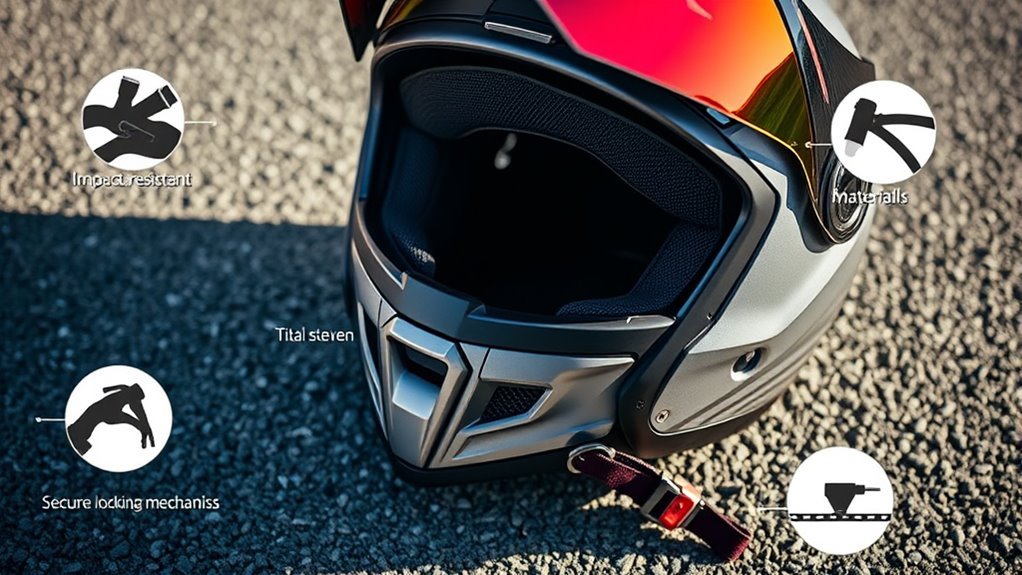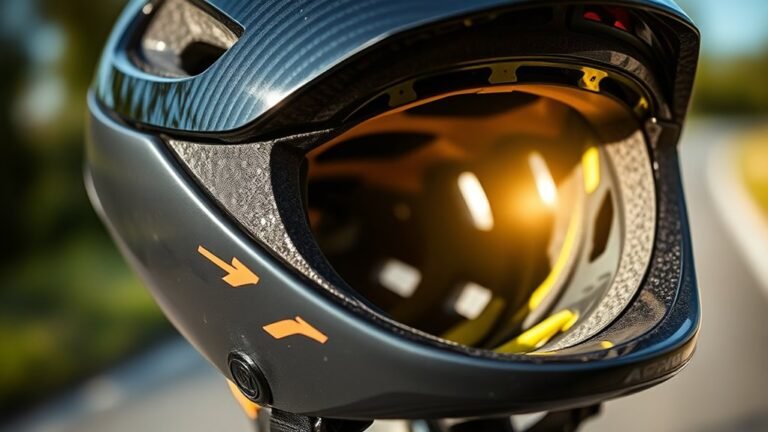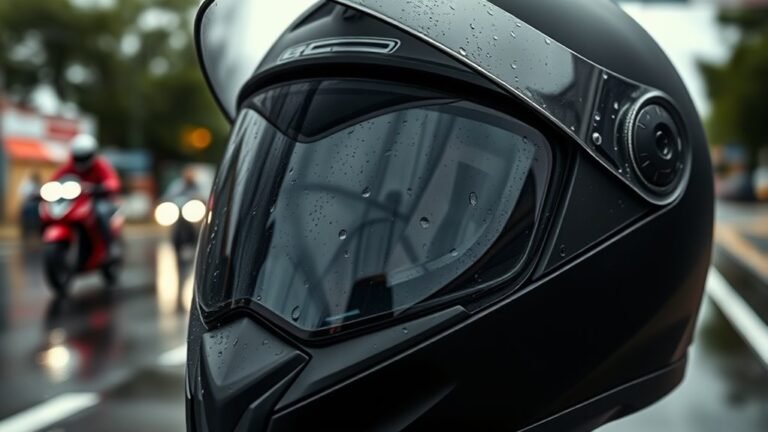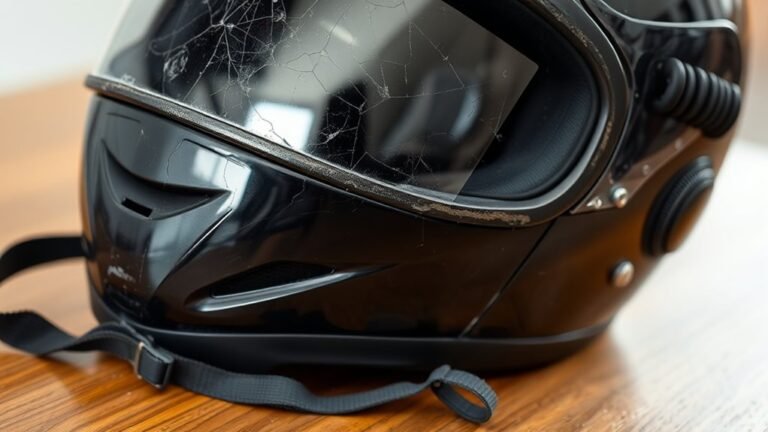Top 10 Safety Features in Motorcycle Helmets
When choosing a motorcycle helmet, consider top safety features like impact resistance and lightweight materials for comfort. Full-face coverage provides maximum protection, while an effective ventilation system keeps you cool. Look for anti-fog visors and multi-directional impact protection to enhance visibility and reduce rotational forces. Snell and DOT certifications are essential for ensuring safety compliance. Comfort padding and fit are also vital for long rides. Explore more to discover additional features that can elevate your riding experience.
Impact Resistance

When it comes to motorcycle safety, impact resistance is one of the most critical features of a helmet. You need to understand that a helmet’s ability to absorb and dissipate energy during a crash can greatly reduce the risk of severe head injuries. Crash testing is essential in determining a helmet’s effectiveness; manufacturers must adhere to specific safety standards to guarantee their products provide adequate protection. Look for helmets that have undergone rigorous testing, such as DOT or Snell certifications, which indicate compliance with these safety benchmarks. By prioritizing impact resistance, you’re not just investing in a helmet; you’re investing in your freedom to ride safely, knowing that you’ve taken the necessary steps to protect your most valuable asset—your head.
Lightweight Materials
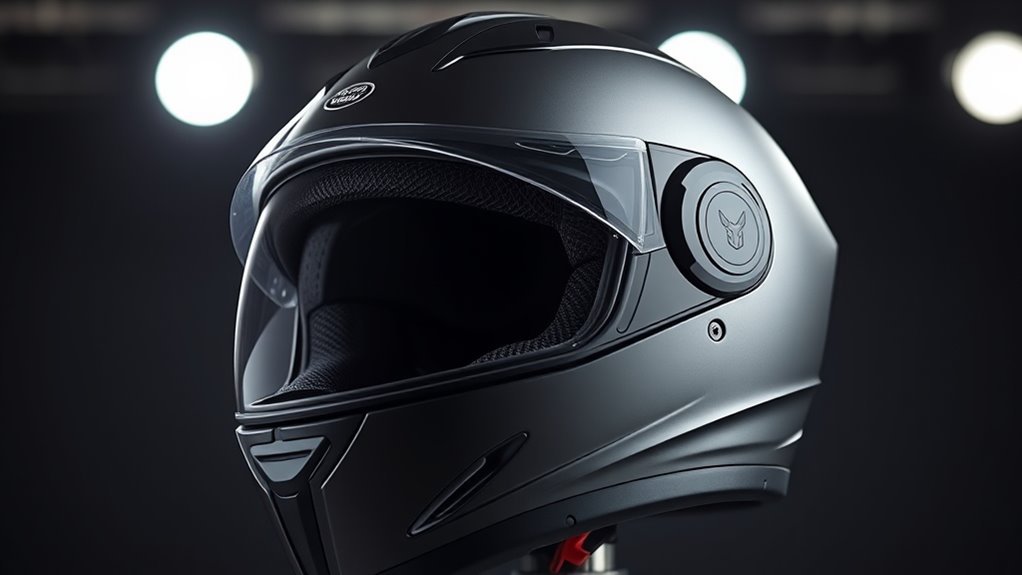
When considering lightweight materials in motorcycle helmets, you’re looking at a balance between impact resistance and comfort. These materials not only enhance safety but also improve maneuverability, allowing for a more enjoyable ride. Understanding these factors can help you make a better choice in helmet selection.
Impact-Resistant Construction
Although you might not think about it when choosing a motorcycle helmet, the impact-resistant construction is essential for your safety on the road. The durability of your helmet largely depends on the construction materials used. High-quality helmets often utilize advanced composites like polycarbonate or fiberglass, which provide excellent impact resistance while remaining lightweight. This combination guarantees that your helmet can absorb energy during a collision, reducing the risk of injury. Additionally, a helmet with superior impact-resistant construction maintains its structural integrity over time, giving you confidence in its performance. When you ride, knowing your helmet is built to withstand impacts not only enhances your safety but also supports the freedom you seek on the open road. Choose wisely for your ride.
Enhanced Comfort Levels
While you might prioritize safety features when selecting a motorcycle helmet, enhanced comfort levels also play an essential role in your riding experience. Lightweight materials are vital for achieving this comfort. Helmets constructed with advanced, lightweight materials reduce fatigue during long rides, allowing you to focus on the open road. An ergonomic design guarantees that the helmet fits snugly without compromising your comfort, distributing weight evenly across your head. High-quality padding materials, such as memory foam or moisture-wicking fabrics, enhance comfort further, providing a soft yet secure fit. These innovations not only improve your riding experience but also keep you more focused and alert. Ultimately, a comfortable helmet can make all the difference in enjoying the freedom of the ride.
Improved Maneuverability Factors
A comfortable helmet not only enhances your riding experience but also considerably influences your maneuverability. Lightweight materials in modern helmets notably reduce fatigue, allowing you to maintain ideal handlebar positioning and body posture. When you can easily turn your head and shift your body, you’ll find it easier to navigate tight corners and respond to changing road conditions.
| Material Type | Weight (grams) |
|---|---|
| Polycarbonate Shell | 1300 |
| Carbon Fiber Shell | 1000 |
| Fiberglass Composite | 1200 |
Choosing a lightweight helmet can make a remarkable difference in your ride, giving you the freedom to maneuver with confidence and precision. Embrace the road ahead without the burden of unnecessary weight.
Full-Face Coverage
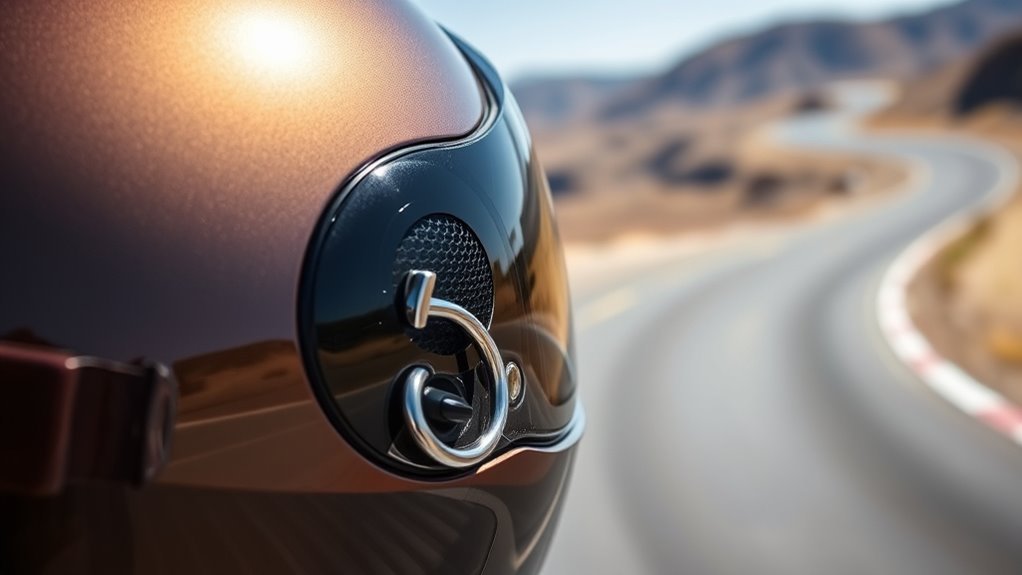
Full-face coverage helmets offer enhanced impact protection by enveloping your entire head, which greatly reduces the risk of injury during a collision. Additionally, these helmets act as a shield against wind and weather elements, providing a more comfortable riding experience regardless of conditions. Understanding these features can help you make an informed choice about your safety on the road.
Enhanced Impact Protection
When considering motorcycle safety, enhanced impact protection through full-face coverage stands out as a critical feature. This design offers thorough protection for your head, face, and chin, greatly reducing the risk of injury in the event of an accident. Helmets with higher safety ratings have been rigorously tested to withstand impacts, providing you with peace of mind as you ride. Additionally, the helmet’s lifespan is essential; regular checks for wear and tear can guarantee peak performance. Investing in a high-quality full-face helmet not only enhances your safety but also empowers your sense of freedom on the road. Fundamentally, the right helmet can make a substantial difference in your riding experience, blending safety with the thrill of adventure.
Wind and Weather Shield
One of the key benefits of full-face helmets is their ability to provide an effective wind and weather shield. This design maximizes wind resistance, minimizing drag as you ride, which is essential for maintaining stability at high speeds. The full coverage not only protects your face but also keeps you warm during chilly rides and shields you from rain and debris. With a snug fit and a visor, you gain enhanced clarity and protection against the elements, allowing you to focus on the road ahead. Investing in a full-face helmet means prioritizing your comfort and safety while embracing the freedom of the ride, ensuring that weather conditions won’t compromise your adventure.
Ventilation System
A well-designed ventilation system is vital for ensuring rider comfort and safety in motorcycle helmets. Effective airflow design allows air to circulate freely, helping to keep your head cool during long rides. With proper temperature regulation, you won’t feel stifled or overheated, which can distract you from the road ahead. Good ventilation also helps prevent sweat buildup, enhancing your overall riding experience. Look for helmets featuring adjustable vents, as they let you customize airflow based on your preferences and riding conditions. Remember, a helmet that balances safety with comfort is essential for those who crave freedom on two wheels. Prioritizing a quality ventilation system can greatly enhance your ride, making every journey enjoyable and safe.
Anti-Fog Visor
While enjoying the ride with a well-ventilated helmet, visibility can still be compromised by fogging. That’s where anti-fog technology comes into play. It helps maintain a clear line of sight, ensuring you can focus on the open road ahead. Many helmets now feature specially treated visors that resist moisture buildup, making your ride safer and more enjoyable.
To maximize the effectiveness of this technology, regular visor maintenance is essential. Clean your visor with appropriate products to avoid scratching and preserve the anti-fog coating. Additionally, storing your helmet in a cool, dry place can prevent fogging during your next adventure. With these features and practices, you’re better equipped to embrace the freedom of the ride without the hindrance of foggy vision.
Emergency Release System
In the event of an accident, having an emergency release system integrated into your motorcycle helmet can be an essential safety feature. This quick release mechanism allows for rapid removal of the helmet, minimizing potential injuries. Here are some key aspects of this safety mechanism:
- Ease of Use: Designed for quick access in emergencies.
- Reduced Risk: Prevents further neck or head injuries during removal.
- User-Friendly: Can be operated even with gloves on.
- Compatibility: Often fits various helmet styles and brands.
- Peace of Mind: Riders can feel secure knowing help can be administered faster.
Multi-Directional Impact Protection
Multi-Directional Impact Protection is essential for enhancing your safety while riding. It focuses on improved energy absorption and reduces the rotational forces that can cause serious injuries during an accident. Understanding these features can help you make an informed decision about your helmet choice.
Enhanced Energy Absorption
Safety in motorcycle riding hinges on advanced technologies, and enhanced energy absorption through multi-directional impact protection is a prime example. By utilizing cutting-edge helmet design innovations, manufacturers are implementing effective energy absorption techniques that considerably reduce the risk of head injuries.
Key features include:
- Multi-layered foam that dampens impact across various directions
- Variable density materials tailored for specific impact zones
- Energy-absorbing liners that compress upon impact, dispersing energy
- Advanced shell structures providing increased durability and flexibility
- Integrated shock-absorbing systems that enhance overall helmet performance
These innovations not only improve your safety but also enhance your freedom as you ride, knowing you’re protected by the best technology available.
Rotational Force Reduction
While enhanced energy absorption greatly mitigates linear impacts, addressing rotational forces is equally essential in helmet design. When you ride, helmets equipped with Multi-Directional Impact Protection (MDIP) can considerably reduce the effects of angular momentum generated during a crash. These advanced systems utilize layers that can slide against each other, effectively managing rotational dynamics. This sliding action disperses the rotational forces that can cause serious brain injuries. By minimizing these forces, such helmets not only enhance safety but also give you the freedom to ride with greater confidence. Opting for a helmet with rotational force reduction features is a smart choice, ensuring that you’re protected against both linear and rotational impacts, ultimately preserving your well-being on the road.
Reflective Elements
Reflective elements in motorcycle helmets play a crucial role in enhancing visibility during low-light conditions. When you’re out there enjoying the freedom of night riding, these features can make all the difference in safety. They allow you to be seen by other drivers, reducing the risk of accidents. Here are some key benefits of reflective elements:
- Increased visibility: Reflective materials bounce light, making you more noticeable.
- Enhanced safety: They provide peace of mind while riding after dark.
- Versatile designs: Available in various styles to suit your preferences.
- Durability: Most reflective materials withstand weather conditions.
- Easy integration: Often incorporated into helmet designs without compromising comfort.
Investing in a helmet with reflective elements is a smart choice for any rider.
Snell and DOT Certification
When choosing a motorcycle helmet, understanding certification standards like Snell and DOT is essential for guaranteeing your protection on the road. Snell certification involves rigorous testing beyond DOT’s minimum helmet standards, focusing on higher impact resistance and performance. It reflects a commitment to safety that’s important for riders seeking freedom without compromising on protection. On the other hand, DOT certification guarantees that helmets meet fundamental safety ratings required by law, providing a baseline level of safety. While both certifications serve significant roles, opting for a Snell-certified helmet can offer extra assurance, particularly for high-speed riders. Ultimately, understanding these standards equips you with the knowledge to make informed choices, safeguarding your adventures on two wheels.
Comfort Padding and Fit
Comfort padding and fit are critical factors in selecting a motorcycle helmet, as they directly influence your riding experience and safety. Helmets with high-quality padding materials help absorb shock and provide comfort during long rides. A customizable fit is essential for guaranteeing your helmet stays securely in place, minimizing distractions while you ride.
Consider these aspects when choosing your helmet:
- Padding thickness: Thicker padding often enhances comfort.
- Material breathability: Look for moisture-wicking fabrics.
- Shape and design: A well-shaped interior can reduce pressure points.
- Adjustable retention systems: Confirm a snug fit.
- Removable liners: Easy cleaning and maintenance enhance comfort.
Ultimately, a well-fitted helmet with superior padding can elevate your freedom on the road.
Frequently Asked Questions
How Often Should I Replace My Motorcycle Helmet?
You should replace your motorcycle helmet every five years, even if it seems fine. Coincidentally, just like a pair of well-worn shoes, a helmet ages and loses its ability to protect you. Helmet replacement guidelines emphasize this timeline to guarantee compliance with current helmet safety standards. If you’ve been in a crash or the helmet shows signs of damage, replace it immediately. Your safety and freedom on the road depend on it.
Can I Wear Glasses With My Motorcycle Helmet?
Yes, you can wear glasses with your motorcycle helmet. Most modern helmets are designed with glasses compatibility in mind, allowing you to easily accommodate your eyewear. However, make certain your helmet fits snugly without being overly tight, as this can affect comfort. Look for helmets with sufficient space around the temple area to avoid pressure points. Ultimately, a comfortable fit enhances your riding experience, giving you the freedom to enjoy the open road.
What Is the Lifespan of a Motorcycle Helmet?
A motorcycle helmet typically lasts about 5 to 7 years, depending on its helmet material and how well you care for it. Helmets must meet safety standards, and after years of use, they can degrade, losing their protective capabilities. If you notice visible damage or if you’ve been in a crash, it’s wise to replace your helmet sooner. Prioritizing safety guarantees you can enjoy the freedom of the open road with peace of mind.
Are There Specific Helmets for Different Riding Styles?
Yes, there are specific helmets for different riding styles. Cruiser helmets often feature a more open design, providing comfort for relaxed rides, while sportbike helmets are typically aerodynamic, enhancing speed and stability. Each type caters to the unique needs of riders, guaranteeing peak performance and safety. When choosing a helmet, consider your riding style to make certain it complements your experience on the road, offering both freedom and protection tailored to your journey.
How Do I Properly Clean My Motorcycle Helmet?
To properly clean your motorcycle helmet, start by removing the visor and any removable liners. Use mild soap and water for the shell, avoiding harsh chemicals. For the visor, a soft cloth and specific cleaning products designed for helmet visors work best. Regular helmet maintenance tips include checking for damage during cleaning. Always let it air dry completely before reassembling. Keeping your helmet clean guarantees both safety and longevity, allowing you to enjoy the ride freely.
